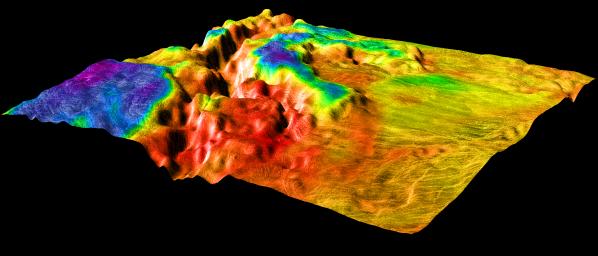There are many spooky landscapes on the earth that are amazing, but looking at the entire solar system, we will see even more magnificent landscapes. Planetary scientist David Rothery recently proposed 5 geological structures that impressed him the most in the solar system.
The first is the tallest volcano in the entire solar system: Mount Olympus (Latin: Olympus Mons), located on Mars, about 600 kilometers wide and twice as high as Earth’s Mount Everest, 21,229 meters above the Martian datum. ruler. Mount Olympus is a shield volcano with a gentle slope. If the number of impact craters is used for dating, the five craters in the crater of Mount Olympus were formed about 150 million years ago. There are some lava flows on the west side of the volcano. The age is 110 million years, and some are only 2 million years old. They are very young in terms of geological time, but no ongoing volcanic activity has been observed.

▲ Aerial shot of Mount Olympus. (Source: NASA)
The second is the linear “deformation belt” mountain range on Venus composed of folds and faults. The size, mass, and density of Venus are almost the same as the Earth, but it lacks the same plate structure as the Earth, which puzzles geologists very much. But at least in some ways, Venus has some landforms that are very similar to the Earth, such as the Ovda Regio region, which is also folded like the Appalachian Mountains, which only lacks rivers.

▲ Ovada District of Venus. (Source: NASA)
The third is the Calori Basin, which is 1,550 kilometers in diameter on Mercury. About 3.5 billion years ago, an asteroid impact formed this crater. Soon the bottom was submerged by lava, and then a lava plain similar to the moon sea was formed. The impact eruption outside the crater around the crater extended for about 1,000 kilometers, creating a surrounding basin. Concentric ring structure.
Strangely, a large range of hills and grooves and a few impact craters appeared on the opposite plantar point of the Calorie Basin. This area is called “Chaotic Terrain”, also known as “Weird Terrain”. ), scientists believe that this is because the shock waves generated by the asteroid impact converge at the antipodal point, and the shock waves may cause Mercury to undergo volcanic activity. In addition to Mercury, Mars, Europa and Europa also have strange chaotic terrain.

▲ This is the chaotic terrain on Europa Europa. (Source: NASA)
The fourth is also quite curious. It is known as the highest cliff in the entire solar system. It comes from the Verona Rupes on Miranda. It is estimated to be 20 kilometers deep, which is 10 times the depth of the Grand Canyon. Due to the extremely low gravity on the surface of Celeste, NASA pointed out that if a person falls from the Verona cliff, it will take 12 minutes to fall to the bottom of the cliff at a speed of 200 kilometers per hour. In contrast, a free fall on the earth does not consider the air. Resistance, it only takes 160 meters or 6 seconds to reach this speed.
However, David Rothery believes that the only image currently available is from Voyager 2 when it flew over Neptune in 1986. It appears that the Verona cliffs are not steep in the photos, and the inclination may be less than 45 degrees.

▲ The highest cliff in the solar system: Verona Rupes. (Source: NASA)
The last one is Titan. It is the moon with the thickest atmosphere in the entire solar system. It also has an ocean of liquid methane called Ligeia Mare and an unforgettable jagged coastline. David Rothery describes it as looking like Homem. Musandam Peninsula on the south side of the Strait. NASA has decided to send the Dragonfly unmanned aerial vehicle to explore this beautiful planet in the mid-2020s.

▲ Picture of the Dragonfly going to the Titans. (Source: NASA)
(First image source: NASA)

